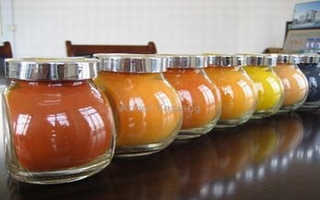 In 2011, the global market for food colors accounted for approximately $1.55 billion in sales, a 13% jump from 2007, per a February 2013 report from Mintel and Leatherhead Food Research. Upon closer inspection, though, the 2-3% annual growth rates since 2007 were well below the 4-5% that this segment registered throughout most of the previous decade.
In 2011, the global market for food colors accounted for approximately $1.55 billion in sales, a 13% jump from 2007, per a February 2013 report from Mintel and Leatherhead Food Research. Upon closer inspection, though, the 2-3% annual growth rates since 2007 were well below the 4-5% that this segment registered throughout most of the previous decade.The bright spot for colors appears to be in natural options. Global sales of natural colors hit an estimated $600 million in 2011, a nearly 29% increase from 2007, a figure that represents a compound annual growth rate (CAGR) of better than 7%. Researchers also found naturals’ share of the total food color market likewise has grown: jumping to nearly 39% in 2011 from 34% in 2007.
Meanwhile, the artificial and synthetic colors market has seen its sales increase by a more modest 4% between 2007 and 2011. Artificial colors account for an estimated $570 million in sales, roughly 37% of the overall market in 2011and well shy of its 40% market share figure in 2007.
Globally, natural colors are used by a two-to-one margin over artificial and synthetic colors. In Europe, those numbers are even more striking: some 85% of new product launches in Europe between 2009 and 2011 featured natural colorings. Although Europe has been the linchpin for growth in natural color sales, research suggests that other geographic regions also are boosting their interest (and purchases) of natural colors. Here too, officials say this global change reflects rising consumer interest and more manufacturers phasing out artificial ingredients.
Foods account for approximately70% of the use of natural colors, with 27% utilized in soft drinks and a relatively paltry 3% used in alcoholic beverages, according to the “Food Colours--International February 2013” report from Mintel and Leatherhead.
What is driving natural color growth? To a certain degree, consumers are simply demanding purity in the products they and their families consume. However, there also are growing concerns about allergies to dyes used in some packaged foods. The dyes tartrazine, carmine, annatto and saffron have all been linked to severe allergic reactions in some individuals. Yet the important thing to note about the allergic concerns is that natural food colorings can be potentially just as allergenic as their artificial counterparts, leading some consumers to avoid colorings altogether.
The Food and Drug Administration long ago concluded there was no definitive link between colorings and behavior or health problems. Nevertheless, there is an abundance of anecdotal evidence linking artificial colors to hyperactivity in children. Compounding matters in this regard has been the Southampton Study and, in particular, the subsequent reaction of several major companies to that report.
The Southampton Study tested six dyes and the combination of two ingredients (tartrazine and sodium benzoate) in the U.K. and led a number of firms to eliminate synthetic colors and sodium benzoate from their U.K. products, including such companies as Kraft, Coca-Cola, Mars and Wal-Mart. Before the study was even published, Wal-Mart’s U.K. brand Asda had pledged to remove any artificial colors or flavors from its 9,000 private-label products, as well as aspartame, hydrogenated fat and such flavor enhancers as monosodium glutamate.
In the U.S., the Center for Science in the Public Interest petitioned the FDA to ban the use of the Southampton six dyes, and a pair of mom bloggers drafted a petition to Kraft Foods to eliminate the food dyes yellow 5 and yellow 6 from its Kraft Macaroni & Cheese. (In the U.K., the Kraft product now uses turmeric and paprika to achieve the yellow color.) Kraft did respond to the petition, noting that it has expanded its U.S. offerings of products with natural food colorings but without indicating any change in the macaroni and cheese product.
For the FDA’s part, its consumer website quotes Linda Katz, M.D., M.P.H., director of the Office of Cosmetics and Colors in FDA's Center for Food Safety and Applied Nutrition (CFSAN): "Color additives are very safe when used properly. There is no such thing as absolute safety of any substance. In the case of a new color additive, FDA determines if there is 'a reasonable certainty of no harm' under the color additive's proposed conditions of use."
This applies to natural and synthetic colorings, alike, but more consumers appear to be opting for natural solutions to food coloring needs.





